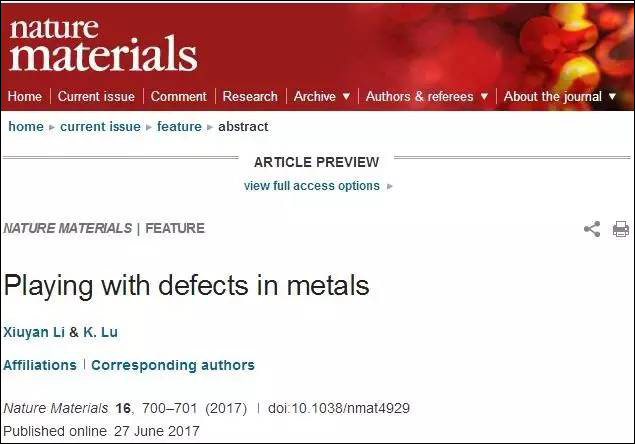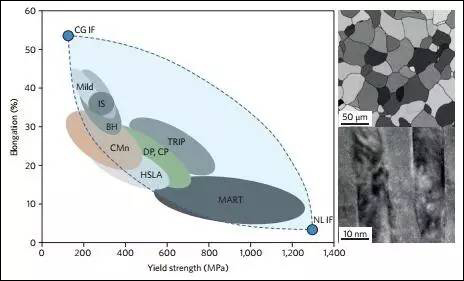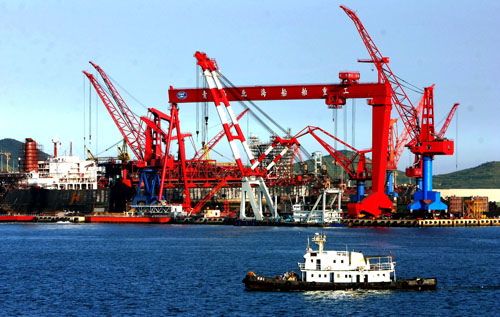近期,中國科學院金屬研究所沈陽材料科學國家(聯合)實驗室研究員盧柯和李秀艷(共同通訊作者)關于材料素化的戰(zhàn)略研究成果Playing with defects in metals 在《自然-材料》(Nature Materials)發(fā)表。
論文鏈接:
http://www.nature.com/nmat/journal/v16/n7/full/nmat4929.html

材料素化是盧柯近年來在對材料科技發(fā)展趨勢的綜合研究分析下提出的新概念。多年來,材料,尤其是金屬材料的發(fā)展依賴于合金化來調節(jié)材料性能,但合金化在很多體系中的發(fā)展?jié)摿⒈M,而且合金化也加重了人們對自然資源的依賴。
材料素化指通過跨尺度構筑與組織結構調控,制造少合金化的“素”材料,大幅度提高材料的綜合性能,實現不(或少)依賴合金化而調控材料的電子結構、晶格及相結構、形態(tài)與尺寸,以及界面表面結構等,減少或替代貴重、稀有或有毒元素的使用。
它為人們解決材料面臨的可持續(xù)發(fā)展的以上難題提供了一個全新的思路。文中指出,實現材料素化的關鍵是有效控制材料中的各類缺陷,這一點材料科學研究仍有很長的路要走。
全文只有一張圖片,如下所示:

Figure 1 | A range of mechanical properties that can be obtained by engineering defects in metals. Strength–ductility correlations for different types of steels. IS, isotropic; BH, bake-hardening; CMn, carbon-magnesium; HSLA, high-strength–low-alloyed; DP, dual-phase; CP, complex-phase; TRIP, transformation-induced plasticity; MART, martensitic; IF, interstitial-free. Coarse-grained (CG) IF steels (a scanning electron microscopy image of their morphology is shown in the top right) are soft and ductile. Nanolaminated (NL) IF steels (a transmission electron microscopy image9 of this morphology is shown in the bottom right) are very hard but less ductile. Gradient nanostructures combining these two extreme morphologies provide a broad range of strength–ductility combinations as outlined by the dashed lines. X.C. Liu is acknowledged for support in preparing the figure. Adapted from ref. 10, Wiley (graph); and ref. 9, Elsevier (right images)。
— END —
更多關于材料方面、材料腐蝕控制、材料科普等方面的國內外最新動態(tài),我們網站會不斷更新。希望大家一直關注中國腐蝕與防護網http://www.ecorr.org
責任編輯:王元
投稿聯系:編輯部
電話:010-62313558-806
中國腐蝕與防護網官方 QQ群:140808414
免責聲明:本網站所轉載的文字、圖片與視頻資料版權歸原創(chuàng)作者所有,如果涉及侵權,請第一時間聯系本網刪除。

官方微信
《中國腐蝕與防護網電子期刊》征訂啟事
- 投稿聯系:編輯部
- 電話:010-62316606-806
- 郵箱:fsfhzy666@163.com
- 中國腐蝕與防護網官方QQ群:140808414





